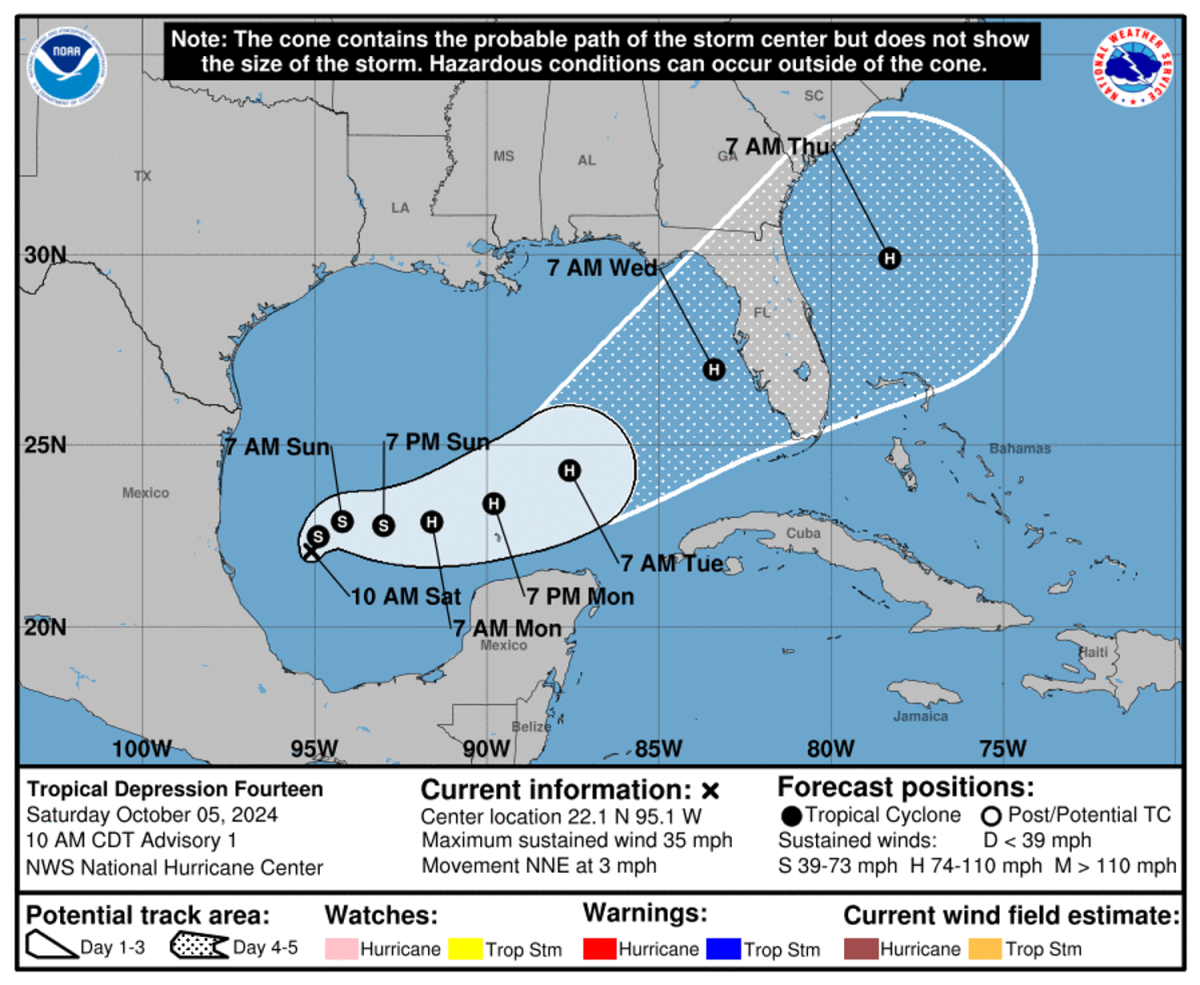Tropical Storm Milton will likely become a major hurricane within three days as it targets Florida’s already storm-ravaged west coast, federal forecasters said Saturday.
The National Hurricane Center said in a forecast review that the storm was rapidly evolving into “an intense hurricane with multiple life-threatening hazards” for the coastline north and south of the Tampa Bay region.
The center’s forecasters said Milton would likely reach hurricane status — defined by sustained winds of 75 mph, followed by major hurricane status — a Category 3 defined by sustained winds of at least 110 mph — within 36 hours in 72 hours.
On Saturday, Gov. Ron DeSantis preemptively declared a state of emergency for 35 counties, including the Pinellas County Peninsula in Tampa Bay, which is still recovering from Hurricane Helene.
The governor’s statement cited possible “life-threatening storm surge and wind impacts” for the state’s west coast beginning as early as Tuesday evening and continuing into Wednesday.
Milton’s explosive growth from tropical depression to tropical storm in the Gulf of Mexico in a few hours presents the storm as yet another potential disaster for the Southeast.
It comes less than ten seconds after Helene made landfall in Florida’s Big Bend region on September 26 and headed towards Tennessee and North Carolina, causing devastating flooding.
In Florida, Helene created waves on September 26, pushing the Gulf of Mexico 8 feet (2.5 meters) into otherwise dry land lined with homes, condos, mobile homes, restaurants, bars and shops, killing 12 people in Pinellas County and 25 more the entire state. At least 230 people in six states died as a result of the storm.
Storm’s path is rare
Milton is fueled by unusually warm waters in the Gulf of Mexico, where a buoy tracked by the National Oceanic and Atmospheric Administration near the storm’s expected path Saturday evening recorded a water temperature of nearly 86 degrees, 2 degrees warmer than the air. The storm is already known for its rare features during a busy Atlantic hurricane season.
It will be the fifth hurricane to make landfall on the U.S. mainland in 2024, tying the most hurricanes ever to make landfall in 2004, 2005 and 1893.
And it’s a rare product of its development in the Bay of Campeche, a sheltered southern spot in the Gulf of Mexico west of the Yucatán Peninsula. Only two storms born there have hit Florida since 1850; no one has done it in 155 years, and the last person to walk that path was recorded in 1867.
Milton is the sixth named storm of the Atlantic hurricane season, which now has the most such storms recorded between September 24 and October 5, according to meteorologist Philip Klotzbach of Colorado State University.
The last time three named storms (including Kirk and Leslie) swirled in the Atlantic Ocean in October was in 2018, he said.
Heavy rain possible ahead of storm
At 5 p.m. ET, Milton was 250 miles north of Veracruz, Mexico, pushing maximum sustained winds at an estimated 40 mph, with some higher gusts, the hurricane center said. It was moving north-northeast at a speed of 3 miles per hour, it said.
According to the latest forecast cone from the Hurricane Center, Milton will reach major hurricane status early Tuesday afternoon and reach the Pinellas County coastline early Wednesday afternoon.
The cone has some uncertainty built into it, with previous forecasts averaging 150 miles (240 kilometers) when projecting a storm’s behavior four days before landfall, the hurricane center said.
“Regardless of where the track goes, it will produce heavy rain,” Jamie Rhome, deputy director of the National Hurricane Center, said in a video update on Saturday.
Hurricane and storm surge watches will likely be needed Sunday for certain regions of Florida, many of which were just hit hard by Helene. The center said areas of heavy rain will hit parts of the state on Sunday and Monday, well ahead of the arrival of the tropical system, increasing the risk of flooding.
Rain from the outer parts of the storm could begin off Florida’s west coast on Sunday, federal forecasters said. Heavier rain is likely on Tuesday and Wednesday, bringing the possibility of flash flooding and moderate river flooding.
Residents are urged to prepare
The system could also produce rainfall of two to four inches in parts of the northern Yucatán Peninsula and western Cuba.
The hurricane center is warning those in these areas, as well as the Florida Peninsula, the Florida Keys and the Bahamas, to keep a close eye on this system for potential impacts.
Residents of the Tampa Bay region and beyond should prepare, the National Hurricane Center said in its forecast discussion.
“Residents in these areas should ensure they have their hurricane plan ready, follow any advice from local officials and check back for forecast updates,” the report said.
Pinellas County does provide sandbags to its residents. The National Weather Service placed the region in the potential path of Tropical Storm Milton, although it is too early to say what impact the storm will have on the county.
Rhome, of the hurricane center, said residents of the state’s west coast should make sure they have several days’ worth of food and water on hand, vehicles are refilled with fuel and cellphones are charged. They should also have necessary prescription medications for a week or two, and have enough cash on hand in case credit, debit and digital payment systems go down.
This article was originally published on NBCNews.com







